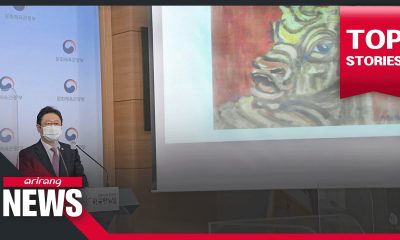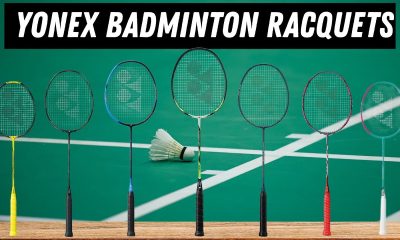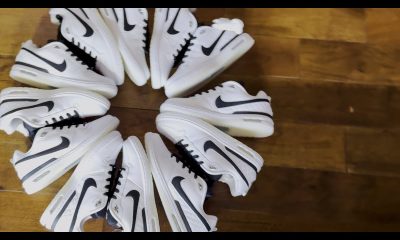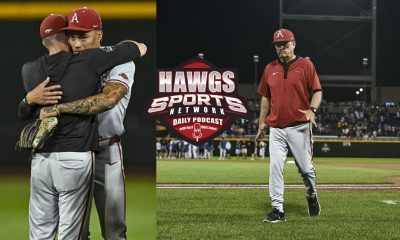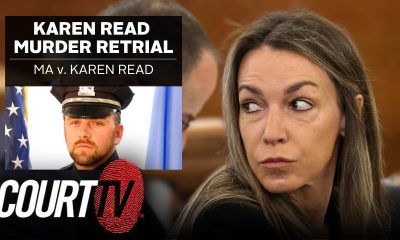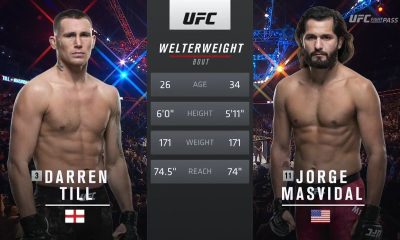The Baltimore Banner thanks its sponsors. Become one.
NIL
Mitchell Robinson should get more playing time in Game 3
Josh Hart is lobbying for more Mitchell Robinson minutes. After the Knicks fell into an 0-2 hole in the Eastern Conference finals, Hart suggested that the 7-footer see more time. “We have to figure out ways — I think he played [29] minutes — figure out ways if he can play more,” Hart said following […]
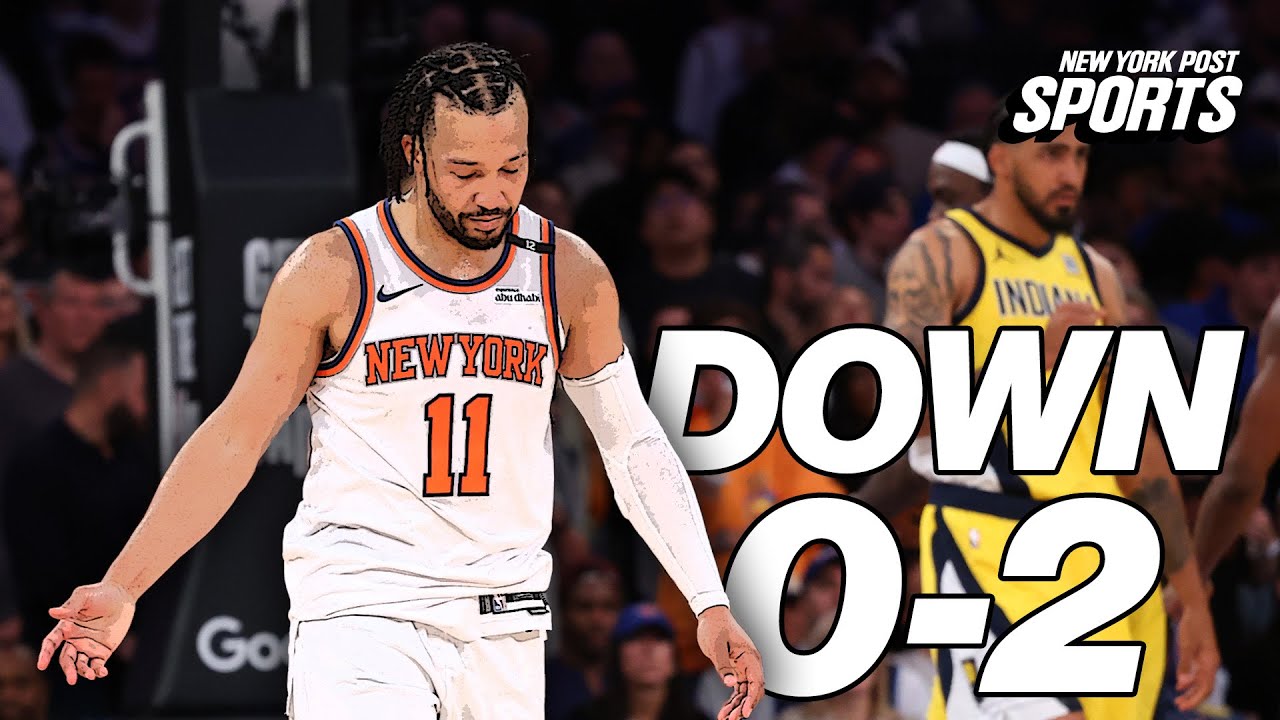
Josh Hart is lobbying for more Mitchell Robinson minutes.
After the Knicks fell into an 0-2 hole in the Eastern Conference finals, Hart suggested that the 7-footer see more time.
“We have to figure out ways — I think he played [29] minutes — figure out ways if he can play more,” Hart said following this 114-109 loss at the Garden. “We’re great with him on [the floor]. We all got to be willing to sacrifice for the betterment of the team.”
The Knicks starters have been outscored by 81 points in the playoffs, and they were again outplayed Friday, digging the Knicks an early 19-9 hole.
They also allowed a 15-7 run to start the third quarter. Coach Tom Thibodeau has been resistant to a shake-up with his first five.
Asked about a potential change after the loss, he said: “We always look at everything.”
He played Robinson a postseason-high 29 minutes in Game 2, and Robinson delivered six points, nine rebounds, three blocks and a team-best plus-six rating.

Game 2 loss to the Pacers on May 23, 2025. Charles Wenzelberg / New York Post
So far in this series, the Knicks have outscored the Pacers by six points when Robinson is on the floor and have been outscored by 14 when he isn’t.
With just over a half-minute left, the Knicks had possession down three.
Jalen Brunson was searching for an open 3-pointer attempt when he opted to give up the ball for a wide open Josh Hart layup that cut the deficit to one.

It left 14.8 seconds on the clock.
“I mean, I was looking for a 3 but I saw him wide open with enough time to kind of play the trap, steal, foul game,” Brunson said. “Obviously, it didn’t go in our favor. We had more than enough time and opportunity to get to where we wanted to get to.”
Aaron Nesmith made two free throws and Brunson was forced into a deep, desperation 3 that was way offoff.
Karl-Anthony Towns sat much of the fourth quarter, logging just five minutes.
He was minus-20 in 28 minutes and struggled on the defensive end all night.
“We got in a hole and then the group that was in there gave us a chance, so we just were riding that,” Thibodeau said. “We were just searching for a way to win.”

NIL
NCAA House settlement FAQ
AI-assisted summaryThe House vs. NCAA settlement allows direct payment to student-athletes and establishes a revenue sharing model.A College Sports Commission will oversee NIL activities and a clearinghouse called NIL Go will review deals over $600.Participating institutions, primarily Power 5 schools, must adhere to a revenue sharing cap and report NIL deals.The world of college recruiting […]
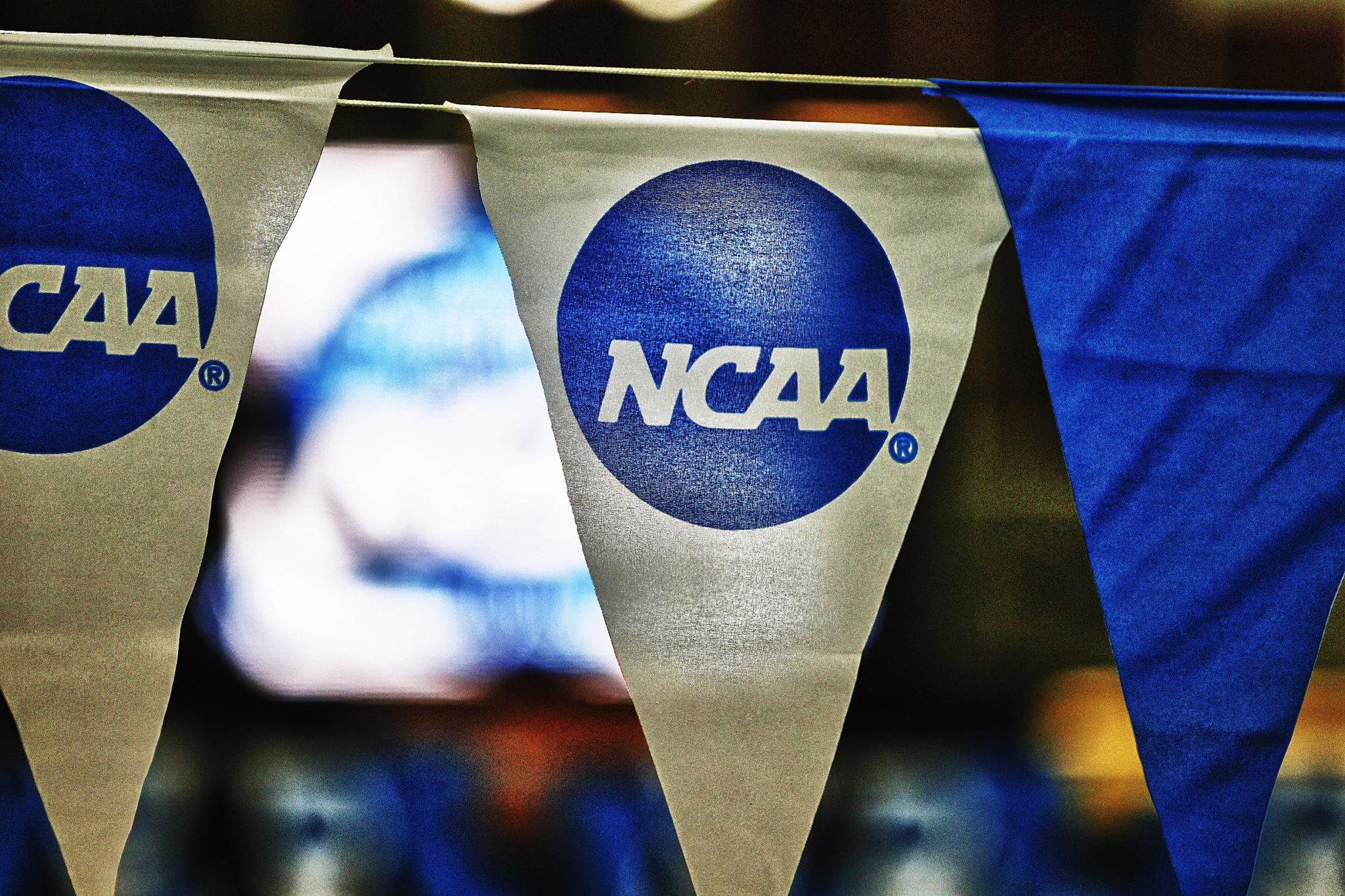

 AI-assisted summaryThe House vs. NCAA settlement allows direct payment to student-athletes and establishes a revenue sharing model.A College Sports Commission will oversee NIL activities and a clearinghouse called NIL Go will review deals over $600.Participating institutions, primarily Power 5 schools, must adhere to a revenue sharing cap and report NIL deals.The world of college recruiting with name, image, and likeness deals has seemed lawless and ungoverned since it initially became legal in 2021.
AI-assisted summaryThe House vs. NCAA settlement allows direct payment to student-athletes and establishes a revenue sharing model.A College Sports Commission will oversee NIL activities and a clearinghouse called NIL Go will review deals over $600.Participating institutions, primarily Power 5 schools, must adhere to a revenue sharing cap and report NIL deals.The world of college recruiting with name, image, and likeness deals has seemed lawless and ungoverned since it initially became legal in 2021.
Now, power conference schools are allowed to directly pay their student-athletes following the settlement of the House vs. NCAA antitrust cases.
The settlement, which was approved on June 13 by a federal judge in California, sets the stage for a tidal wave of confusion as schools, student-athletes, and their families navigate the uber-legislated college athletics ecosystem.
With the passing of the settlement also comes the formation of the College Sports Commission, which will become the new enforcement arm of college athletics.
The NCAA, along with the defendant conferences, released a 36-page Question & Answer package to address many of the common concerns and hurdles people are experiencing following the settlement.
Here are some of the biggest questions to how college athletics will operate pertaining to NIL under the new House settlement, and how the NCAA answered them in their document, which they released shortly after the settlement was approved:
Who is affected by the House Settlement?
![Florida Gators athletic director Scott Stricklin looks at the scoreboard during the second half against the Kentucky Wildcats at Steve Spurrier Field at Ben Hill Griffin Stadium in Gainesville, FL on Saturday, September 10, 2022. [Matt Pendleton/Gainesville Sun]](/gcdn/authoring/authoring-images/2025/06/08/SGAT/84102751007-usatsi-20909715.jpg?width=660&height=440&fit=crop&format=pjpg&auto=webp)
The House settlement forced the NCAA to pay nearly $2.8 billion in back damages over the next decade to any student-athlete that competed from 2016 to present day.
Looking forward, the House settlement will have an influence on every Division I athletic program, its administrators and coaching staffs, current and prospective student-athletes, their families, and fans as well.
Any schools named in the settlement or intend on joining by this year’s June 30 cutoff date are referred to as “Participating Institutions.”Who are Participating Institutions?All current members of the SEC, Big Ten, Big 12, Pac-12, and ACC are part of the new revenue-sharing model.What do Participating Institutions have to do now?The NCAA makes clear the obligations schools have following the settlement, including:Ensure that any additional payments or benefits being provided comply with the benefit cap and cap-related rules, policies and procedures.Report to the cap management reporting system (CAPS):All licenses between the institution and its student-athletes for name, image andlikeness; andAny other payments or benefits provided beyond what was permitted by NCAA Division I rules as of October 7, 2024, assuming such benefits are otherwise permitted by NCAA rules.Report all additional benefits that count against the benefits cap to CAPS and complete the annual attestation by September 1 after the close of each academic year.Adhere to the established roster limits.Agree that the designated enforcement entity (i.e., College Sports Commission) has theauthority to enforce NCAA Bylaws adopted as part of the settlement (e.g., roster limits,additional payments and benefits and noninstitutional NIL).Is there a cap to how much revenue a school can share?


NIL Go is run by Deloitte, a major consulting firm. It’s works as an online portal that student-athletes, schools, and third-party payees will use to verify that an NIL deal meets the criteria of a true third-party deal.
All players must submit deals to NIL Go within five business days of execution of the contract. From there, Deloitte and NIL Go will determine if the deal meets “valid business purposes” for an NIL contract.
Who is enforcing the new rules under the House Settlement?
The College Sports Commission will oversee NIL Go. The CSC was created by the major conferences to act as a self-policing arm of the NIL era. The CSC, headed up by former MLB executive Bryan Seeley, will determine if schools break any rules and then determine the appropriate punishments.
Seeley answers directly only to the Power-4 commissioners that hired him to police their conferences.
How will NIL Go judge if a deal is valid?
When the player agrees to the NIL contract or payment terms, it must include the promotion or endorsement of goods or services provided to the general public for profit. Otherwise, it is not a valid third-part deal and will be rejected by the clearinghouse.
Deloitte recently shared data that 70% of past NIL payments from boosters and collectives would have been denied under the current scrutiny.

How do multiyear agreements count against the revenue sharing cap?
Additional payments promised in multiyear agreements are counted against a Participating Institution’s benefits cap in the year that the payments and/or benefits are provided.
For example, if a player signs a two-year agreement for $100,000 through 2025-27, the first $100,000 would count towards the school’s cap in 2025-26, and the second $100,000 would count against the 2026-27 cap.
If the contract includes incentives, the total amount of incentives will count against the cap of the year that they promised. If the player fails to meet the criteria for the incentive, the amount is removed from the cap at the end of the year.
Who is a third-party under the House Settlement, and who isn’t?
Because where a money originates from decides whether or not it counts towards the cap, determining true third-parties is more essential than ever.
Associated entities/individuals are anyone that is known to have promoted a school’s athletics program, created or identified NIL opportunities, assisted in recruiting, or contributed more than $50,000 over their lifetime to a school (for individuals).
Are boosters considered associated individuals under the House Settlement?
Boosters are not automatically considered associated individuals. However, any booster or “Representative of Athletic Interests” defined by NCAA Bylaw 13.02.16 would automatically become an associated individual by the definitions set forth in the House Settlement and NCAA bylaws.
How do transfers and buyouts work under the new House Settlement?

Every contract is different, but the principles will be the same throughout. If a player transfers out of a school before the end of their contract, the school is only obligated to pay the terms of the contract that are valid up to the date they enter the portal. Any money that would have been owed to the player that transferred out can be removed from the benefits cap.
Take for example, a player that signs a deal that pays $100,000 per year over the course of two years. If the player transfers out before the start of the second year of the contract, the school is off the hook for the back end of the contract because it was never owed or due.
If there is a buyout clause in a player’s contract, the school that the player is transferring into must pay the entirety of the buyout to the school that the player departed from. The buyout also counts against the paying school’s cap, but cannot be added to the receiving school’s cap.
NIL
How Maryland's fastest high school sprinter scored a ground
Elise Cooper will go to the Olympics one day. The fastest high school sprinter in Maryland is one of the most promising racers the state has produced in recent years, setting a national record for the indoor 300-meter dash in February. She’s headed to Texas this fall on scholarship, and her dream of qualifying for […]
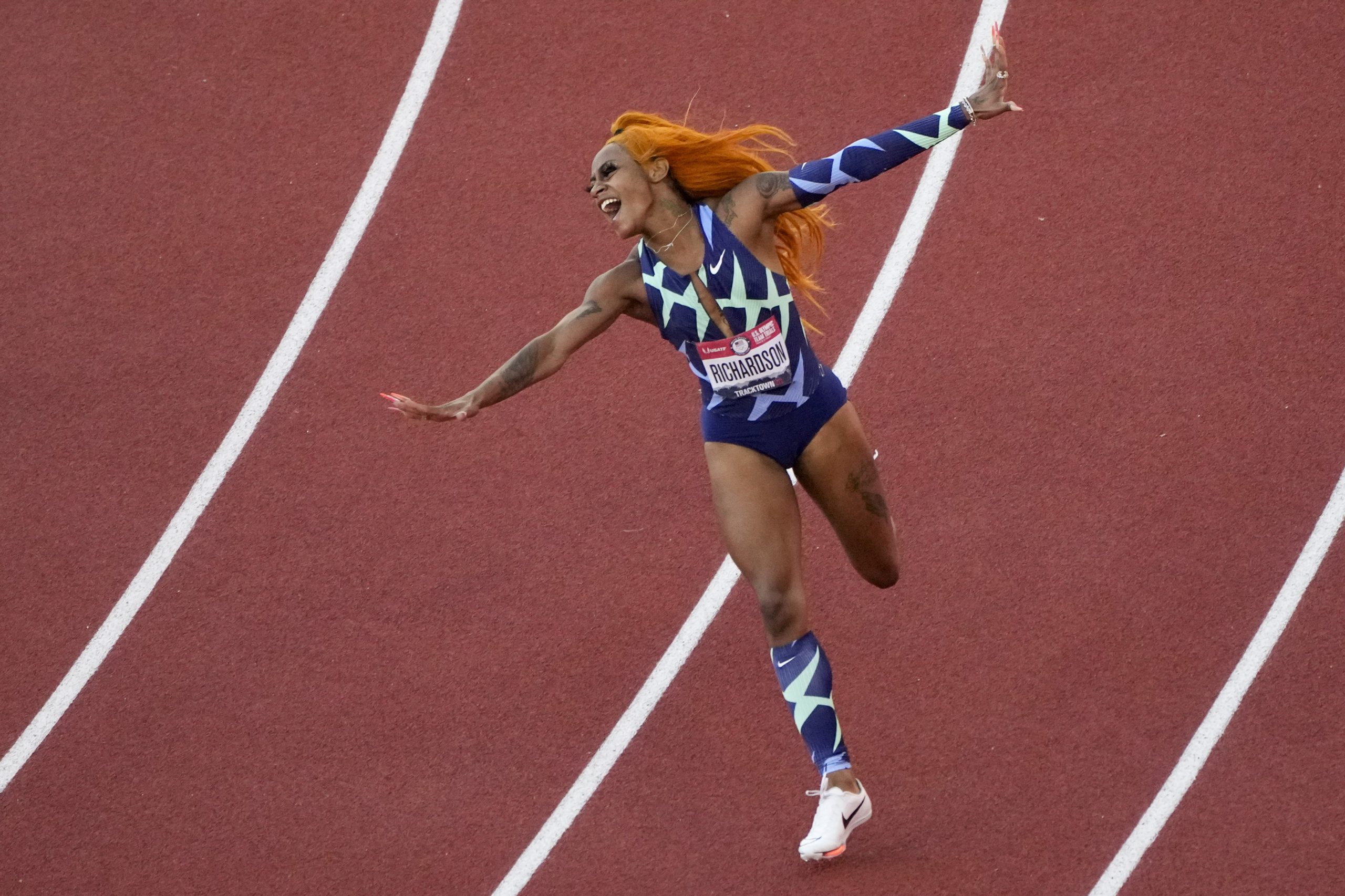
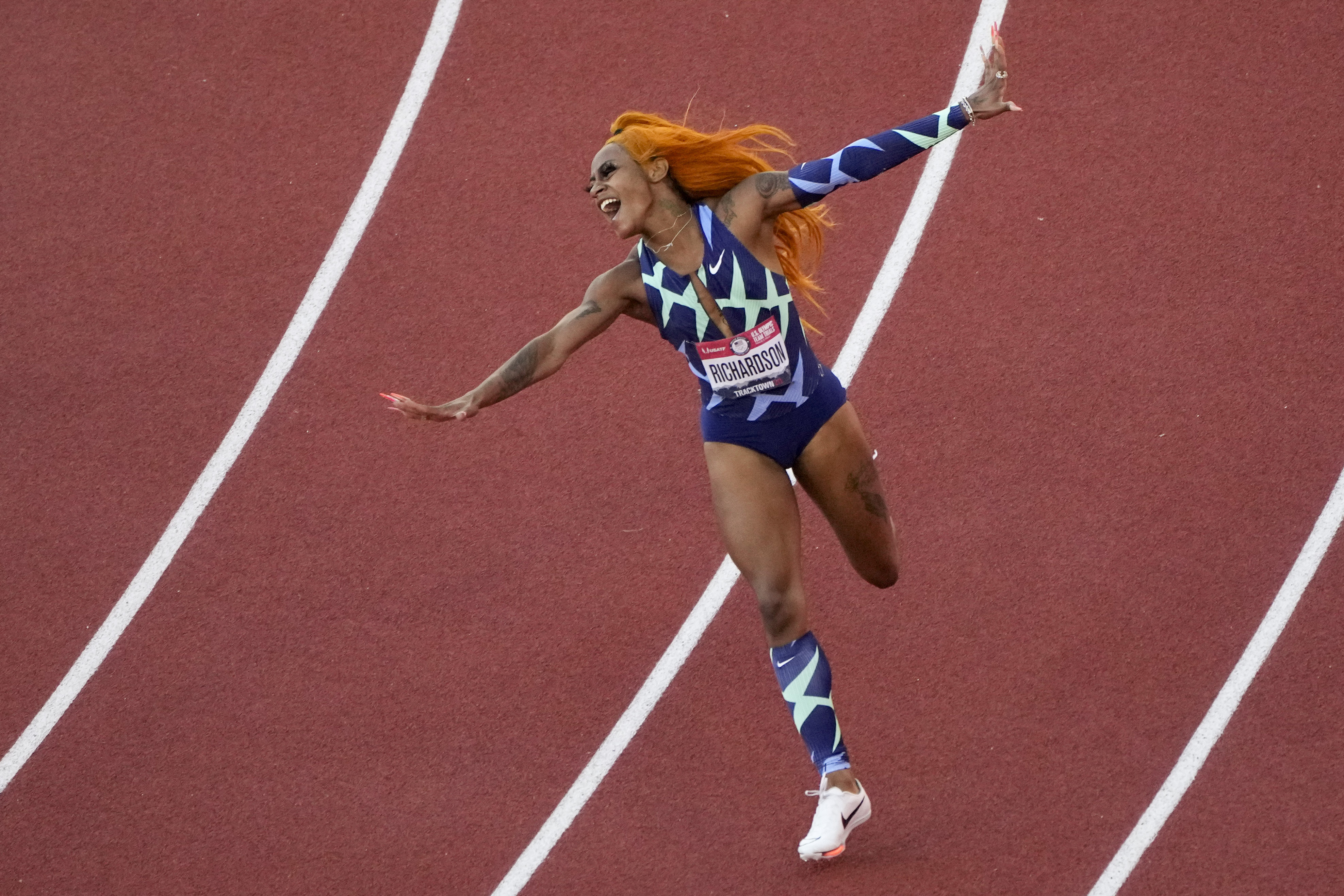
Elise Cooper will go to the Olympics one day.
The fastest high school sprinter in Maryland is one of the most promising racers the state has produced in recent years, setting a national record for the indoor 300-meter dash in February. She’s headed to Texas this fall on scholarship, and her dream of qualifying for the 2028 Games looms in the distance.
But, in the modern era of sports, with the money that floods the landscape, other goals arrive much faster — faster than a teenager is usually prepared for.
On her 18th birthday, Cooper signed her first name, image and likeness deal with Puma, essentially becoming a pro sprinter for one of the world’s biggest sports apparel companies on her first day of legal adulthood. Even before she signed, the outfitter had sent boxes of gear to her home in Owings Mills — all the free shoes, shorts and sweats the McDonogh School student could have imagined streaming through her door.
There was only one catch. Until the company announced the deal, she had to keep one of the most exciting things ever to happen in her career a secret from her closest friends.
For nearly three months this spring, the knowledge burned within her chest. At track practice, her teammates would notice her head-to-toe wardrobe from Puma, sniffing a deal was in the works.
Cooper’s strategy? Deny, deny, deny.
“I was low-key gaslighting them,” Cooper said. “I would just tell them, ‘I like wearing the stuff.’ It was longer than I thought. Way longer.”
In April, Puma finally made public what the Cooper family kept to themselves for what felt like an eon — Cooper was the company’s first high school sprinter signed to an NIL deal, a landmark move in a brand-new market. Only a few years ago, such young athletes would never have been allowed to profit off their athletic careers — and also compete collegiately — in the name of protecting the American curiosity formerly known as “amateurism.”
The Baltimore Banner thanks its sponsors. Become one.
It’s a new day for athletes and their families, who for the first time have the ability to cash in on NIL agreements that pay off years of hard work, even if they’re teenagers in high school. But it’s also a new, potentially treacherous marketplace with few regulations and even fewer experts who can give good advice.
For nearly two years, the Coopers considered various deals from some of the biggest companies in sports, holding out past offers of free gear, of flights to national meets and the prestige of being one of the first high schoolers to get signed.
Danielle Cooper — Elise’s mother, whom she lovingly calls her “mom-ager” — consulted dozens of parents, coaches, lawyers and industry pros in an effort not to get the most profitable deal for her daughter but the one that made the most long-term sense. Even the people she asked knew mostly one corner of the business. Almost no one is evaluating the bigger picture of a rapidly evolving landscape. What is a caring parent to do?
“Basically, no one knows,” Danielle Cooper said. “Even the people you think should know don’t really know. It’s really hard to go on.”
An uncharted economic frontier
It has been less than four years since NIL deals were permitted by the NCAA, a moment that stands as a starting pistol in a race toward economic chaos. Although the new system corrects flaws of the amateurism model by distributing more money into the pockets of the athletes who generate it, the clandestine nature and shadowy rules of the marketplace defy easy understanding for the families caught in the swirl. Especially for Olympic or so-called “non-revenue” sports.
The Baltimore Banner thanks its sponsors. Become one.
Bill Carter, the founder of Student Athlete Insights, hears NIL stories and questions all day long from families who haven’t thought much about the money before. A family of a highly rated lacrosse recruit recently went on a college visit during which an NIL collective offered their child $30,000 to enroll at that university.
The family had been largely considering other factors: academics, coaching staff, the program’s track record. Suddenly, they were ambushed by new questions.
Is $30,000 a good deal? Should we go to other schools and ask what their NIL offers are? Could we negotiate more money? Would that be too pushy?
“They left stunned,” Carter said. “They didn’t know whether it was the deal of a lifetime or an insult.”
While deciding whether to accept tens of thousands of dollars may be a good predicament to face, the families of these elite athletes are increasingly finding themselves in these positions. Markets have stabilized somewhat for Division I football and basketball players, and parents can more easily find what might constitute a fair NIL deal based on the school and the position their child plays.
The Baltimore Banner thanks its sponsors. Become one.
But in track the field of top-flight talent is so small — Carter estimates as little as 0.02% of even NCAA track and field athletes draw significant NIL interest — there isn’t any sort of conventional wisdom for how these deals should work.
Prep track meets are dominated by a few shoe companies, particularly Nike and New Balance, which annually run competing meets they each call “nationals.” Elise is running this weekend in the New Balance Nationals at Penn. She’ll be a top competitor in the 200 and 400 meters — largely because it’s easier to drive to Philadelphia than it is to fly to Eugene, Oregon, where Nike stages its event.
The first NIL deals the Cooper family heard about were stipends, around $1,000 or so, from these companies to cover the cost of travel and lodging for their big meets, drawing elite competition into the field. These are typically accompanied by flattering social media posts and, of course, complimentary gear.
For a teenager, a pair of free shoes is a sweet siren song. Elise figured she should start her strides into the NIL market by taking one of the short-term agreements. Danielle was not as convinced, especially after talking to a family friend who has worked as a sports agent.
“It was my mom who talked to other people and made the decision to hold out,” Elise said. “I kinda wanted stuff now, but I started to understand more after doing more research. NIL’s always evolving, so I’ll never fully understand it.”
The Baltimore Banner thanks its sponsors. Become one.
Confusing by design
The confusion around NIL deals, especially at the high school level, is not by accident. It’s by design.
The Maryland Public Secondary Schools Athletic Association offers a seven-page NIL guidance that has one key rule: When an athlete makes a deal, they cannot be wearing their high school uniform or use content captured from high school competitions. The regulations mainly serve to keep the MPSSAA separate from the economic frenzy.
Carter said that is a common approach by high school associations across the country. They are most concerned with keeping themselves, and their intellectual property, apart from the NIL chase — what he describes as a legal “moat” around the schools. The list of “do-nots” can help the associations, but it rarely offers much help to families.
“The conversations people frequently have around NIL are almost entirely viewed through compliance or almost entirely viewed through seizing the opportunity — but those conversations rarely converge,” Carter said. “It’s so rare they come together, even though that would benefit the athlete the most.”
The way anyone learns anything about NIL is by exhaustively asking around. Not everyone is lucky enough to have Danielle Cooper as a mom or Owings Mills Track Club coach Michael Ray as a supporting resource.
The Baltimore Banner thanks its sponsors. Become one.
Ray and the Coopers made it their mission to get as much guidance as possible. They talked to Quincy Wilson, the Bullis School standout who won a relay gold medal at 16 last year in Paris (he signed with New Balance). They spoke with the Whittaker family, whose daughters Juliette and Isabella both went to the Olympics last year. They spoke to coaches and employees affiliated with brands, trying to figure out what the structure of a fruitful long-term deal would look like.
But even knowing the framework (not necessarily the dollar value, which can be hard to fish for, even among friends) of some of these deals helped only somewhat. In track, value can be extremely subjective, and even more so for a high schooler who, although she has run in the Olympic Trials, has not captured the international success that others with deals already have on their résumés.
“Because it hasn’t become commonplace, you’re really setting the journey that’s brand new,” Ray said. “There’s no standard deal. They might have an idea of what your value might be, you might have a totally different idea, but there’s no template. It’s hard being the first.”
Athletes and their families are not the only ones taking timid steps into the market. The brands themselves have spent the last few years trying to figure out the best way to get in on high schoolers, too.
José (pronounced “yo-say”) van der Veen, Puma’s global head of product line management, ran middle distances in her native Netherlands before going to the University of Texas El Paso in the late 1990s. She had a small regional deal with Puma that she had to give up because of NCAA rules — “I was a little bit bummed at the time,” she said — so she appreciates how quickly the circumstances have changed.
Puma fancies itself a youthful and energetic brand, capitalizing on the colorful personalities of gold medal-winning sprinters like Usain Bolt and Julien Alfred as its spokespeople. While Nike and other brands were quick to jump into exploring high school NIL deals, Puma was more circumspect. There were so many differing state regulations, so few certainties in investing in athletes so young.
“It’s uncharted,” van der Veen said. “For our in-house lawyers, it’s a space we want to be fair and be a little cautious. But the market, that’s where it’s moving to. You obviously have to go there because other brands are going there.”
Elise Cooper was a good candidate for Puma because she’s fast, first and foremost. But it’s also no accident that the brand wanted a candidate with the kind of support system Elise has in her corner.
Her parents were both athletes, and both her sisters are track stars, too (twin sister Elena is heading to Stanford, while older sister Ella competes for Harvard). She’s competed for Owings Mills Track Club under Ray for more than a decade, and Ivy League schools recruited her for her academic prowess before she committed to the Longhorns.
With high school athletes especially, companies want good long-term investments when they bring a teenager into the fold.
“The line to become professional athletes, it’s not linear,” van der Veen said. “Elise seems to have a very good support network around her. If she gets injured, if something happens, she’s smart enough to figure out it won’t define her. … At the highest level, the talent of these athletes eventually becomes pretty similar. It comes down to how mentally tough you can be.”
How a deal came together
The day Elise Cooper set a national record was unusual not because there was some electric feeling in the air leading up to her run — it was the opposite.
Cooper was at The Circuit in Philadelphia on Feb. 28, the day before the meet started in earnest. In the video, there is almost no one in the stands. She was racing against her friend Sydney Sutton from the Bullis School.
Cooper came into the race hoping for a personal record, but she did not imagine smashing Shawnti Jackson’s record by more than three-tenths of a second — a massive gap in the blink-length margins of sprinting.
“I guess I felt fast,” she said. “But I looked at the clock and I was like, ‘Oh my God!’”
Although Cooper prides herself on her ability to perform under pressure, one of her best runs ever came in one of the most low-stakes races of her career. But the days of racing in front of empty stands are numbered, and even more is on the line now that she’s under her first pro contract.
Track deals, maybe even more than those in other sports, are laden with incentives. Athletes get bonuses for reaching PRs, for clocking under certain times, for winning big meets. Although the Coopers did not share all details of Elise’s contract with The Banner, her deal with Puma — as well as future extensions she hopes to sign — have some of these incentives.
The unusual thing about track deals, however, is also the potentially hazardous piece: Sometimes, athletes who get hurt or don’t meet specific goals end up giving money back to their sponsors. Ray has seen it happen with other athletes he’s coached.
There are so many inherent tensions with signing track stars in their teens, it can be hard to decipher what kind of business arrangement makes sense.
“You at least have to look at it with an eye toward the future and what the individual athlete might accomplish,” Ray said. “A good deal in 2025 might not be a good deal in 2026 if you go to college and set the world on fire.”
Trying to be mindful of all of these factors, the Coopers sought a deal with a company that could mature over time. Puma wasn’t the only brand they considered. They liked On Running, a relative upstart from Switzerland founded in 2010, but the company didn’t have as long a track record with sprinters as Puma did. Ultimately, the relationships with the company and the Puma spikes themselves helped seal the Coopers’ decision to sign.
“A lot of people were saying, ‘This is the shoe she’s going to run in if she goes to the Olympics in 2028,’” Danielle said. “So that got in my head, and I was like, ‘Well I really do like On as a brand.’ But then … you’re gonna have to wear that shoe.”
The red carpet treatment from Puma felt particularly special for the Coopers, who traveled to the company’s American headquarters in Boston together. Elise tried out new gear, saw shoes in development that won’t be released for years, and had her feet closely measured for potential custom work down the line.
Puma is a Formula 1 racing sponsor, and Elise (who is a huge fan of F1) could be attending the Grand Prix in Texas in October as a special guest of the brand. A flight to the company’s world headquarters in Germany is sometime in the future.
But with all the perks comes pressure. Danielle has emphasized to Elise that she has to start thinking of track in more serious terms. No late nights cavorting in her friends’ hotel rooms before a big race. Although Elise will wear Nike gear when she competes for Texas under the school apparel deal, she’s contractually obligated to wear Puma at all other events (Ray bought Puma gear for himself as a show of solidarity).
For the previous 10 years, track was Elise’s passion. She still loves it, but now it’s her job.
“I think, when she saw the contract,” Danielle said, “it was when she realized, ‘OK, this is the real deal.’”
Everything on the line
Since she was 7, the sound of the starting gun has always given Elise a jolt.
It’s a little burst of fear that has never fully gone away — a tic that annoyed Elise when her mom pointed it out to me. “OK, first of all, that wasn’t even relevant,” she said, rolling her eyes in Danielle’s direction.
Danielle dotes on her daughters, and while Elise sometimes teases that the parenting style can feel over the top — Danielle has a running gag that she will buy an RV next year to drive to her daughters’ various meets — she ultimately embraces her mom’s dedication to her career. On her notes app on her phone, there’s a long to-do list of things she wants Danielle to accomplish.
“Not even halfway finished,” Elise playfully jabbed. “Wow, look at that.”
As much as she can push back on her mom’s devotion, she deeply appreciates the fact she probably would have never landed the deal with Puma without that level of diligence. Having a parent who can do this much legwork is a luxury not every athlete has.
Carter said the one piece of advice he would give every family trying to navigate the NIL market is to have patience. If a deal is on the table, there’s a good chance it will stay there for weeks or months. He estimated 90% of the regrets he hears from people are that they pounced too quickly.
“I would tell anyone to slow down and think about the ramifications of it before you sign it,” he said. “Spend a little bit of time thinking about who might help you: an attorney, someone to review the contract, a financial adviser. Get their input, and move through the process slowly.”
The market could help athletes and families by stabilizing and adding regulation. As the NCAA moves into revenue sharing, there’s a sense that NIL will become less important to the overall economics of sports — and companies would welcome some corralling from the Wild West the space is now.
It reminds van der Veen of the chaos in the late 2010s when “super spikes” hit racing and led to records all over getting slashed. Over the next few years, regulating bodies stepped in, other companies caught up and the field evened out again. She hopes the forces overseeing NIL in the NCAA and high schools have a similar flattening effect soon.
“I know the coaches are getting together right now, saying, ‘Hey, we really need to protect these Olympic sports,’” she said. “I really think, in the next couple of months, you’ll see pushback against the rules, more regulation of it. It will get more established and clearer.”
But it’s also likely that elite track athletes like Elise Cooper will always be a kind of outlier, that there may never be one template for the best deal or partnership that makes the most sense or carries the least risk. There may be less than a dozen high schoolers in any given year with the talent to attract contracts from big companies, and their families will always have steep learning curves in the short window that such deals are available.
What helps the Coopers is how independent Elise is when it comes to the races. She warms up and prepares on her own, mentally envisioning the race — tamping down her quickening pulse as she awaits that sharp bang of the starting gun that has never quite lost its intimidating bite.
“The difference between her and other athletes for me is she’s always able to get race ready on her own,” Danielle said. “She’s never needed me for the race. She’s always been independent in her preparation.”
There’s more on the line now than ever for Cooper, an axiom for her career from here until (at least) she shoots for Olympic gold in 2028. But the list of goals she has are all about her PRs — not about her salary, college or world titles or even earning all the free shoes in the world.
That’s why those around Elise see the Puma contract not as the conclusion to a saga but merely another step. That’s what everyone is hoping for.
“You see when the kids get serious about it and what that means for the sacrifices they make for themselves,” Ray said. “Usually the motivator is something beyond money. They really want to be the best of the best.
“Elise,” he added, “is one of those people.”
NIL
ASU, Arizona offer test case for success in rev-share era
Ground zero for the new era of college sports is a 100-mile stretch of interstate in the Sonoran Desert. Which school, Arizona or Arizona State, will thrive in the era of revenue share and legitimate NIL? The outcome will reveal much about the competitive balance within the state and across major college sports. Do campuses […]
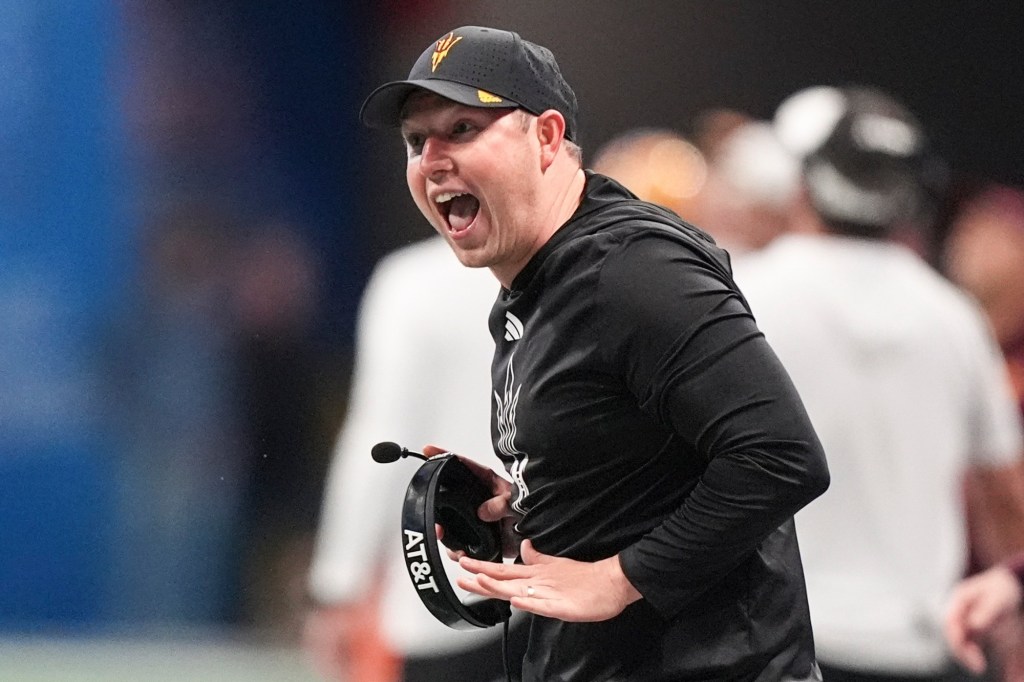
Ground zero for the new era of college sports is a 100-mile stretch of interstate in the Sonoran Desert. Which school, Arizona or Arizona State, will thrive in the era of revenue share and legitimate NIL? The outcome will reveal much about the competitive balance within the state and across major college sports.
Do campuses in major cities possess an advantage?
How might market competition from professional sports impact success?
Will high-profile basketball programs undercut football success?
The Sun Devils and Wildcats are bitter rivals competing in the same conference and the same (public) university system, but their locations and resources are wildly different.
Nowhere else is the contrast as stark.
UCLA doesn’t have a UC system rival located in a college town.
Washington and Washington State aren’t in the same conference or university system.
Georgia and Georgia Tech might be roughly comparable if their locations were flipped.
New York City, Philadelphia and Dallas are devoid of public universities that compete in the Power Four. Houston is bigger than Phoenix, but the Cougars don’t have a bitter natural rival in the Big 12.
The dynamics in Arizona will unfold against an established backdrop: Fair or not, the Sun Devils are considered an underachiever in major college football and basketball; the Wildcats are viewed as an overachiever.
But that backdrop seemingly has little relevance in the new era. The House vs. NCAA lawsuit settlement — former ASU swimmer Grant House is the named plaintiff — will change the economics of college sports like nothing else.
Two pillars are particularly relevant for the Sun Devils and Wildcats:
— Schools can share up to $20.5 million with athletes beginning in 2025-26. Across the power conferences, roughly $15 million will be earmarked for football, with $3.5 million to $4.5 million to men’s basketball and the rest to Olympic sports. (The Big 12 will permit schools to allocate as they see fit.)
— The power conferences created an NIL clearinghouse designed to eliminate the pay-for-play anarchy that has existed during the recent era of booster-run collectives. Athletes are now required to report NIL deals of $600 or more. A technology platform, NIL Go, will assess whether the contract terms fall within a reasonable range of compensation. Deals that are initially rejected can be altered and resubmitted, or the athlete can choose arbitration.
How might those factors play out in Tucson and Tempe? Where does the advantage lie?
Clearly, the Sun Devils will have more opportunities for legitimate NIL deals in metropolitan Phoenix (population: 5 million) than Arizona athletes will in Tucson (1 million).
But the Sun Devils also have more competition for dollars and attention with the Diamondbacks, Cardinals, Suns and Mercury.
In Tucson, all eyes are on the Wildcats. There’s only one option for businesses seeking exposure through partnerships with sports teams or franchises.
But that’s just one piece of the broader calculation in the post-House world.
Arizona will undoubtedly feel compelled to allocate more revenue to its men’s basketball program than the average power conference school. Every dollar plowed into basketball could be one less dollar available for football.
Kansas, UCLA, Kentucky and North Carolina are in similar positions. Arizona State is not. The Sun Devils have always valued football above basketball and seemingly can share the maximum with coach Kenny Dillingham’s roster.
“(Power Four) schools where basketball is king are going to have to make an important choice under the House settlement terms,” sports attorney Mit Winter wrote on the social media platform X.
We don’t know the specifics, but it’s easy to envision ASU spending $1 million-to-$2 million more on football than the Wildcats. (One thing they have in common: Both schools must fund baseball at a competitive level, which isn’t the case for some schools in the Big 12.)
Will the elite basketball program’s lofty status undercut resources for Arizona football?
Will the passion of a college town in the era of legitimate NIL trump the big business opportunities that exist in a pro sports market like Phoenix?
And how will the internal dynamics play out? Will the schools continue to subsidize their athletic departments at current levels? How committed to success is longtime ASU president Michael Crow? What about new Arizona president Suresh Garimella?
If the campus-level commitments are equivalent, the Wildcats and Sun Devils could offer an unfiltered look at the new world order — at the role fan passion, competitive priorities and business communities will play in shaping the roster-building process.
Will the big-city schools gain an insurmountable advantage?
Or does the edge lie with the only thoroughbred in a one-horse town?
Bitter rivals in the Big 12 could offer a fascinating test case for success in the post-House world.
*** Send suggestions, comments and tips (confidentiality guaranteed) to wilnerhotline@bayareanewsgroup.com or call 408-920-5716
*** Follow me on the social media platform X: @WilnerHotline
Originally Published:
NIL
Lincoln Riley Catching Heat After Marcus Freeman’s USC-Notre Dame Comments
Lincoln Riley Catching Heat After Marcus Freeman’s USC-Notre Dame Comments originally appeared on Athlon Sports. With the landscape of college football frequently changing, certain aspects of the sport have also begun to look different over the past few years. Advertisement Whether it’s the expansion of the College Football Playoff, the wild west that is NIL […]
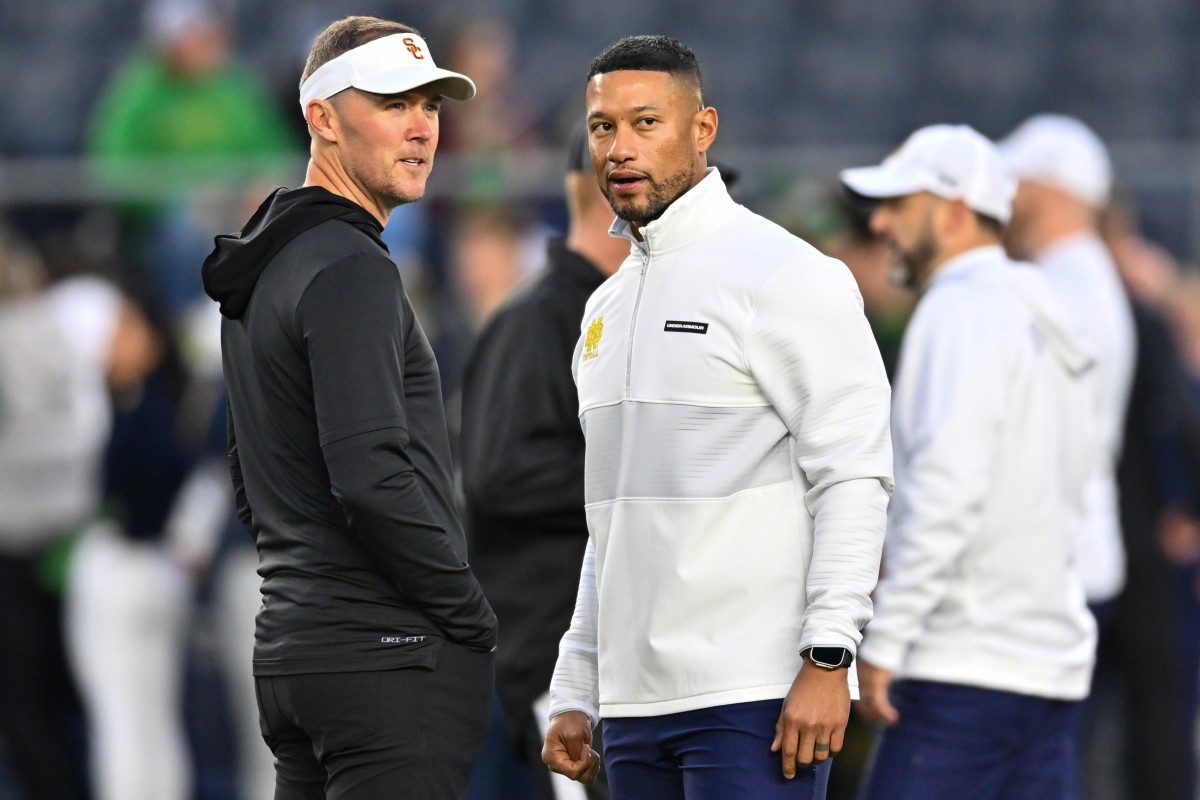
Lincoln Riley Catching Heat After Marcus Freeman’s USC-Notre Dame Comments originally appeared on Athlon Sports.
With the landscape of college football frequently changing, certain aspects of the sport have also begun to look different over the past few years.
Advertisement
Whether it’s the expansion of the College Football Playoff, the wild west that is NIL and the transfer portal or conference realignment, the sport looks infinitely different than it did five years ago.
One of the casualties of realignment has been historic rivalries, as programs such as Oklahoma and Oklahoma State are no longer playing, and they aren’t the only one who have faced that fate or eventually will.
As fans look ahead to the next few years, one historic college football rivalry that seems to be on pace to cease to exist is USC and Notre Dame. The two programs have played every year since World War II outside of the COVID season, yet the partnership is only scheduled through 2026.
In a recent interview with Joel Klatt, Notre Dame head coach Marcus Freeman made it clear he doesn’t want the game to come to an end, but expressed “it takes both parties to tango.”
Many fans took this as a nod at USC coach Lincoln Riley who hasn’t been vocal about continuing the rivalry at all, with many imploring Riley to help save the rivalry.
Advertisement
“Freeman understands rivalry games and why they’re important. That coward in LA doesn’t get it, and would rather have a soft schedule,” wrote one user.
“Marcus Freeman keeps showing Lincoln Riley how easy it is to talk about the USC-Notre Dame rivalry,” chimed in another.
“One coach is vocally and emphatically committed to playing the rivalry. One coach skates around the question constantly. The easiest case of good guy/bad guy I’ve ever seen,” added a third.

USC Trojans head coach Lincoln Riley and Notre Dame Fighting Irish head coach Marcus Freeman.© Matt Cashore-Imagn Images
Earlier this month Riley was asked about addressing the future of the game by On3’s Pete Nakos, and seemingly dodged the question with a vague open-ended statement.
Advertisement
“We will at the appropriate time,” said Riley.
There is still some time before this rivalry ultimately ends, but clearly Notre Dame is making it known they aren’t the ones holding up the process.
Related: Former USC Commit Raves About Meeting With Ex-Trojans Head Coach
This story was originally reported by Athlon Sports on Jun 18, 2025, where it first appeared.
NIL
College athletes defend free, frequent movement in transfer-heavy era
Hailey Van Lith was one year away from tying a bow on a traditional college basketball career at Louisville and being cemented as one of the most decorated four-year starters in Cardinals history. She had just led the Atlantic Coast Conference program to its third straight appearance in the NCAA Division I tournament’s Elite Eight […]
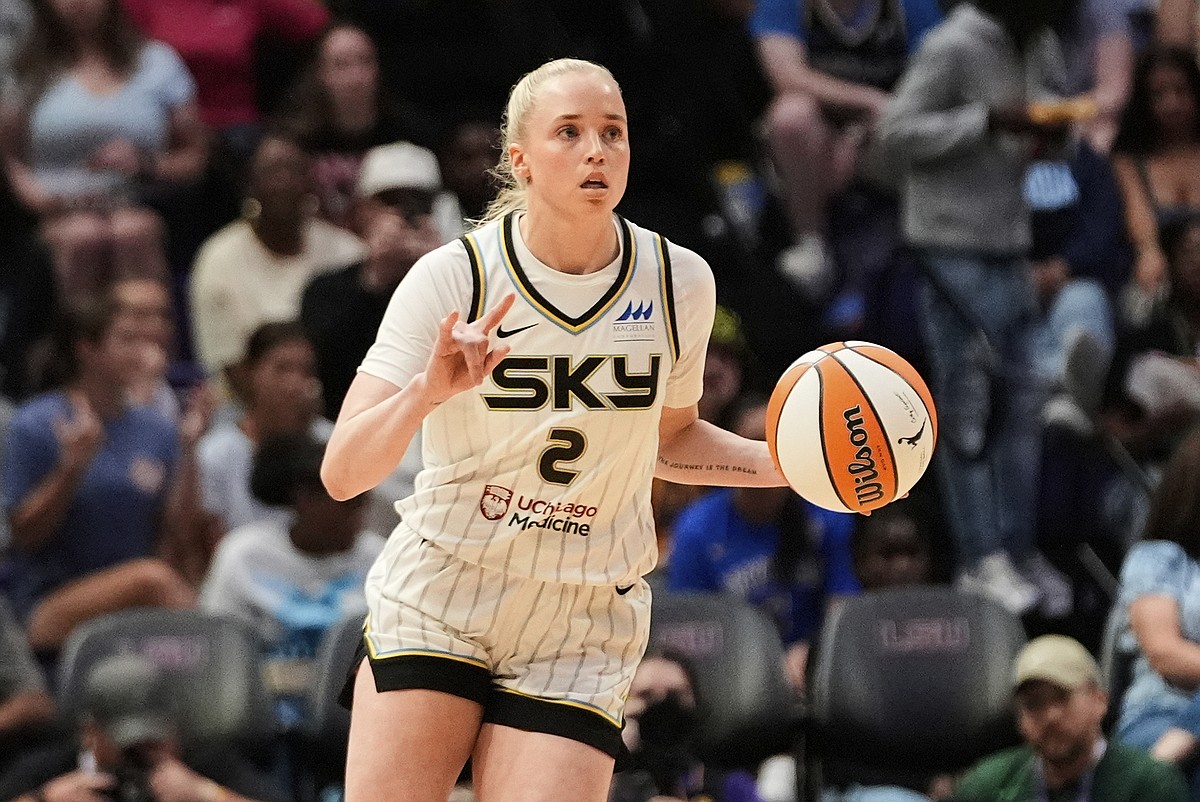
Hailey Van Lith was one year away from tying a bow on a traditional college basketball career at Louisville and being cemented as one of the most decorated four-year starters in Cardinals history.
She had just led the Atlantic Coast Conference program to its third straight appearance in the NCAA Division I tournament’s Elite Eight and put up career-high numbers, including 19.7 points per game.
However, the 5-foot-9 point guard from Wenatchee, Washington, had other plans. With WNBA aspirations on her mind, Van Lith swapped Louisville red and black for LSU purple and gold and embarked on a new journey with the Southeastern Conference’s Tigers in Baton Rouge, Louisiana. Her lone season included another run to the Elite Eight, and it was back to the transfer portal.
Coach Mark Campbell’s pro-style offense caught her eye, and she decided her fifth and final year of eligibility would be spent at TCU. There, she helped the Horned Frogs win the Big 12 regular-season and tournament titles, followed by Van Lith’s final Elite Eight run, this time in purple and white.
College sports was once rooted in tradition, school pride and loyalty, but those expectations are changing — if not fading — in a landscape where athletes have won the ability to transfer season to season, year to year. Some are painted as disloyal or selfish, but Van Lith and others don’t see it that way.
“Whenever you transfer, you always expect pushback,” Van Lith — now with the Chicago Sky after being taken No. 11 overall in the WNBA draft in April — told The Associated Press. “I can’t tell you how many podcasts I’ve seen on people discussing my choices to go to this school and that school, and the theories that are thrown out there are all wrong. But it’s just, you learn to live in harmony with that, and at the end of the day, I just decided I’m no longer going to let false assumptions disrupt my peace.”
One of the biggest misconceptions, Van Lith said, is that her transfer decisions were guided by NIL compensation. She was able to look past accusations of being a “money chaser” or a “trophy chaser” and find solace knowing onlookers didn’t have the full picture.
“Multiple of the schools that I went to, I actually never got a check from,” she said. “I think that in transfer culture now, a lot of people automatically assume that it has to do with the collective money, or now I guess it’s revenue share. But it just depends on the person, and for me, it was all basketball decisions.”
Ann Skeet, the senior director of Leadership Ethics at Santa Clara’s Markkula Center for Applied Ethics, said all parties should be held to the same standards. Coaches and athletic directors take new jobs, navigating buyouts and ill will along the way.
“I do think one of the realities of sport in this day and age is that people are making changes more often than they used to,” Skeet said. “How they communicate what their decision is, how much time they give people, how frequently they’re changing teams, all of those things should be considered, and I think it’s fair to hold the coaches and players to equal standards.”
Skeet acknowledged the pressure on athletes navigating a new, professional-like industry at a young age. Millions of dollars in name, image and likeness compensation is already flowing even before schools start cutting revenue-sharing checks after July 1 under the House v. NCAA antitrust lawsuit settlement.
“The reality is, NIL is bringing market pressures to college sports in a way that we haven’t experienced before, and so players are having to trade off and think about what serves their own personal interests versus what serves the team interests in ways that they haven’t had to consider in the past,” she said.
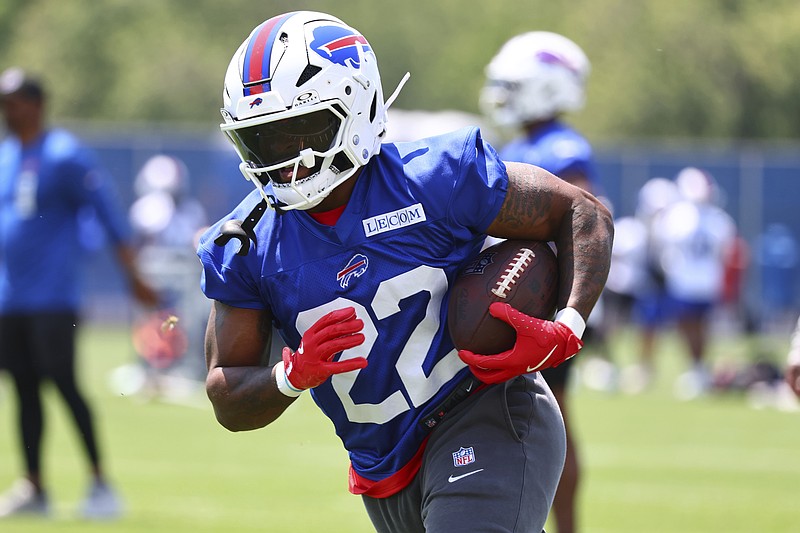
While Van Lith was deciding her future, running back Ray Davis was awaiting his. In his sole season at Kentucky, Davis rushed for 1,129 yards on 199 carries and led the SEC with 21 touchdowns from scrimmage. His production was enough to garner interest from NFL scouts.
Similar to Van Lith, Davis’s winding road to the pros involved several stops. Before Kentucky, he had two-year stints at American Athletic Conference member Temple (2019-2021) and Vanderbilt (2021-2023), another SEC program. Transferring to Kentucky meant Davis would suit up for his third team in five years, and he knew moving from one league school to the next could stir the pot.
The decision wasn’t an easy one.
“It was super difficult,” Davis said. “It took days, literally almost weeks to just really make a decision. And when I made the decision, I just had to live with it. I couldn’t think twice about it. I had to be confident.”
The move paid off. Davis gained national attention and was selected by the Buffalo Bills in the fourth round of the 2024 draft. While his draft stock soared, though, the backlash from transferring a second time took a toll.
“Mentally it sucks because, you know, as a kid when you’re 18, 19 or whatever, you’re being told, ‘Hey he’s leaving because he’s disloyal,’ and that’s not what it is,” Davis said.
He focused on what he could control.
“I think it’s really about how you handle it yourself, how you internalize it yourself, and how you go about walking in the building each and every day. If you be like, ‘Ah, people are looking at me like I’m not an honest and disloyal person,’ then that’s going to hurt you mentally. But if you walk into a place where you’re confident in who you are, then I think you’ll succeed,” Davis told AP.
Transfer decisions, regardless of the underlying factor, can lead to unfavorable public perceptions — or worse. A 2024 study found a cross-section of abusive content directed toward college athletes on social media.
“It certainly is their right to transfer, but then they will also develop whatever reputation they develop as a result of the choices they make. So people who transfer multiple times are going to be identified in that way,” Skeet said. “It goes with the territory, as they say.”
Davis and Van Lith both noted the irony in receiving blowback when team personnel can seek new ventures without repercussions.
“Coaches leave. Directors leave. Everybody has the opportunity to leave. So for players, we’ve got to have that opportunity too,” Davis said.
Added Van Lith: “A lot of times, the loyalty is placed on the responsibility of the players, but you see coaches leave all the time to better their financial situation, to make more money, to do better for their family. When people talk about loyalty, I really challenge them to put into perspective, if they would feel the same if a coach left.”
NIL
Horned Frogs in the News, June 1-15, 2025
From NIL to moving back in with parents, and from runoff elections to First Amendment rights, media come to TCU for news and thought leadership. TCU teams, athletes prove it’s an ‘everything’ school. Let’s hand out some awards Vasean Allette, Jack Bech ’25, Hailey Van Lith, Savion Williams ’24 TCU Athletics June 16, 2025 Fort Worth Star-Telegram Queering home Lauren […]
From NIL to moving back in with parents, and from runoff elections to First Amendment
rights, media come to TCU for news and thought leadership.
TCU teams, athletes prove it’s an ‘everything’ school. Let’s hand out some awards
Vasean Allette, Jack Bech ’25, Hailey Van Lith, Savion Williams ’24
TCU Athletics
June 16, 2025
Fort Worth Star-Telegram
Queering home
Lauren Hope Walker MFA ’24
June 13, 2025
Dallas Voice
TCU’s athletic director opens up on NIL and a new era for college football
Mike Buddie, director of Intercollegiate Athletics
June 12, 2025
Fort Worth Star-Telegram
How to get along when college grads move back home with parents
Eric Wood, director
Counseling & Mental Health Center
June 12, 2025
AP News
Can you wear a mask at a protest in Texas? Here’s what state law says
Daxton “Chip” Stewart, professor of journalism and assistant provost for research
compliance
Bob Schieffer College of Communication
June 12, 2025
Fort Worth Star-Telegram
Oklahoma: Wildlife Commission Greets New Member Eric Chapman
Eric Chapman RM ’91
June 12, 2025
The Outdoor Wire
When are ICE protests ‘illegal’ in Texas? Here’s what state and federal laws say
Daxton “Chip” Stewart, professor of journalism and assistant provost for research
compliance
Bob Schieffer College of Communication
June 11, 2025
Fort Worth Star-Telegram
How to achieve process integration using the Design Structure Matrix (DSM)
Tyson Browning, professor of operations management
Neeley School of Business
June 11, 2025
Process Excellence Network
The One Thing You Should Never, Ever Do in the First Hour After Waking Up,
According to Cardiologists
Dr. Paul Bhella, professor of internal medicine
Anne Burnett Marion School of Medicine at TCU
June 11, 2025
Yahoo!Life
TCU, North Texas announced as base camps for 2026 FIFA World Cup
TCU
June 11, 2025
Fort Worth Star-Telegram
TCU catering team celebrates with silver award at national food service competition
TCU Catering
June 10, 2025
Fort Worth Report
TCU Taps Reuben Burch as New Vice Provost for Research
Reuben F. Burch V, vice provost for research
Floyd L. Wormley Jr., provost and vice chancellor
Academic Affairs
June 10, 2025
Fort Worth Magazine
TCU Appoints Reuben Burch as Vice Provost for Research to Boost Funding and Innovation
Reuben F. Burch V, vice provost for research
Academic Affairs
June 10, 2025
Fort Worth Inc.
TCU Course Puts Real Decision-Making Power Behind Student Philanthropy with $200,000
in Donations
Ron Pitcock, Wassenich Family Dean
Sarah Vartabedian, assistant professor of professional practice
John V. Roach Honors College
June 9, 2025
Dallas Innovates
TCU hires vice provost of research to lead efforts to become R1 university
Reuben F. Burch V, vice provost for research
Academic Affairs
June 9, 2025
Fort Worth Star-Telegram
Trump Tariffs Likely to Raise Prices on Refrigerators, Washers and More. How to Save
on Appliance Purchases This Year
Travis Tokar, professor of supply chain management
Neeley School of Business
June 9, 2025
Cnet.com
If it seems like attacks on expressive freedoms in Texas are escalating, it’s because
they are | Opinion
Daxton “Chip” Stewart, professor of journalism and assistant provost for research
compliance
Bob Schieffer College of Communication
June 9, 2025
Austin American-Statesman
Texas Moves to Curb Orphan Wells, But Critics Say Loopholes Remain
Tom Seng, assistant professor of professional practice
Neeley School of Business
June 9, 2025
Planetizen
Keller ISD names lone finalist for superintendent. Here’s what comes next
Cory Wilson Ed.D. ’23
June 9, 2025
Fort Worth Report
Mia Hall secures spot on Fort Worth City Council in District 6 runoff
Keith Gaddie, Hoffman Chair of the American Ideal and professor of political science
AddRan College of Liberal Arts
June 8, 2025
KERA News
Superb Woman: Chatashia Brown
Chatashia Brown M.Ed. ’21
June 8, 2025
Texas Metro News
I’m a Cardiologist, and This ‘Relaxing’ Habit Is Actually Harming Your Heart Health
Dr. Paul Bhella, professor of internal medicine
Anne Burnett Marion School of Medicine at TCU
June 7, 2025
Parade
Help! My Niece Is Learning Something Shameful From Her Mother. I Can’t Let This Happen.
Jeannine Gailey, professor of sociology
AddRan College of Liberal Arts
June 7, 2025
Slate
Innovation in Orbit: TCU Team Designs for NASA’s Future
Amarige “Sunny” Yusufji and Daisy Li, biochemistry majors
Suzanna Tesfamicheal and Adelaide Lovett, fashion merchandising
June 5, 2025
Moreover.com
Institute in Fort Worth seeks flourishing of people and nature
Blake Hestir, professor of philosophy, associate director of CALM Studies
AddRan College of Liberal Arts
June 5, 2025
Green Source DFW
Over 14,000 undergrad students graduate from Tarrant County colleges
Chancellor Emeritus Victor J. Boschini, Jr.
Chancellor Daniel W. Pullin
June 3, 2025
Fort Worth Report
JPMorganChase and TCU Ralph Lowe Energy Institute Forge Powerful Partnership to Shape
Fort Worth’s Energy Future
Nikki Morris, executive director
Ralph Lowe Energy Institute
June 2, 2025
Fort Worth Report
-

 High School Sports2 weeks ago
High School Sports2 weeks agoParents Speak Out As Trans Pitcher Throws Shutout In MN State Quarterfinals
-

 Professional Sports2 weeks ago
Professional Sports2 weeks ago'I asked Anderson privately'… UFC legend retells secret sparring session between Jon Jones …
-

 College Sports3 weeks ago
College Sports3 weeks agoIU basketball recruiting
-

 Health2 weeks ago
Health2 weeks agoOregon track star wages legal battle against trans athlete policy after medal ceremony protest
-

 Professional Sports2 weeks ago
Professional Sports2 weeks agoUFC 316 star storms out of Media Day when asked about bitter feud with Rampage Jackson
-

 High School Sports3 weeks ago
High School Sports3 weeks agoThe Arizona Daily Star's top high school athletes, coaches and moments of the 2024
-

 NIL3 weeks ago
NIL3 weeks agoNCAA Sends Clear Message About Athlete Pay and Roster Limits
-

 Social Media3 weeks ago
Social Media3 weeks agoControversial Athletics Gender Dispute Goes Viral After Riley Gaines Lashes Over Authorities
-

 NIL3 weeks ago
NIL3 weeks agoMen's college basketball Top 25 reset
-

 Rec Sports3 weeks ago
Rec Sports3 weeks ago2x NBA All-Star Reacts to Viral LeBron James Statement






